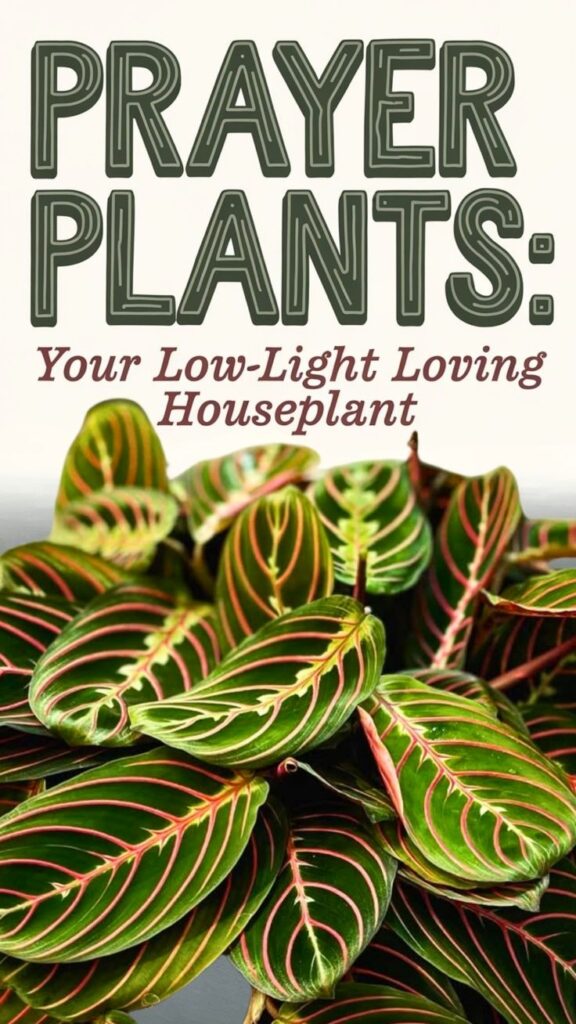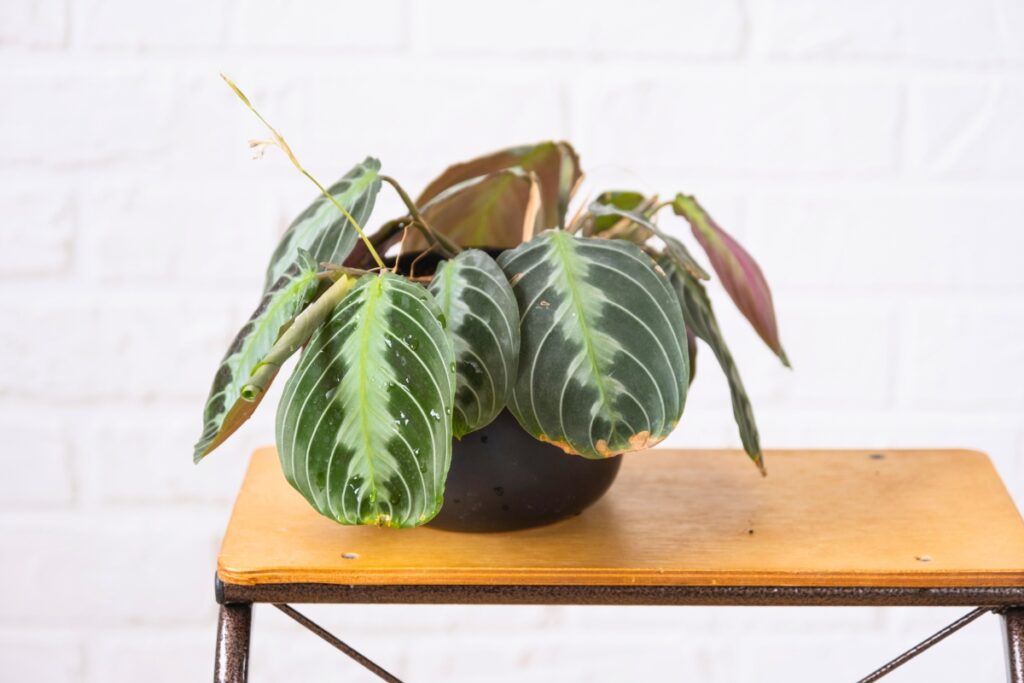While prayer plants are known for their dramatic leaf movements in bright spaces, you’ll be surprised to learn they can actually adapt quite well to dimmer conditions. Your Calathea or Maranta might grow more slowly in low light, but they’ll still showcase their distinctive leaf patterns and daily movements. If you’re wondering how to keep these tropical beauties thriving in your darker corners, there are several key adjustments you’ll need to make to your care routine.

Contents
- 1 Understanding Prayer Plant Light Requirements
- 2 Signs Your Prayer Plant Needs More Light
- 3 Best Prayer Plant Varieties for Low Light Conditions
- 4 Maintaining Growth in Dim Environments
- 5 Adjusting Care Routines for Less Light
- 6 Maximizing Available Light Sources
- 7 Common Challenges in Low Light Settings
- 8 Success Stories: Prayer Plants in Dark Corners
- 9 Essential Care Tips for Shade-Grown Prayer Plants
- 10 Seasonal Light Adaptations for Prayer Plants
Understanding Prayer Plant Light Requirements
While prayer plants have gained popularity as indoor decorative foliage, their lighting needs often confuse novice gardeners. You’ll find these tropical beauties prefer bright, indirect light that mimics their natural habitat beneath the rainforest canopy.
Place your prayer plant 3-6 feet from an east or north-facing window for ideal growth. If you’ve got a west window, you’ll need to diffuse the afternoon light with a sheer curtain to prevent leaf scorching.
Don’t worry if you’re working with lower light conditions – prayer plants can adapt, though they’ll grow more slowly and produce less vibrant foliage patterns.

Signs Your Prayer Plant Needs More Light
When your prayer plant isn’t getting enough light, you’ll notice some telltale signs in its growth patterns and appearance. Your once-vibrant leaves may start looking washed out or dull, while stems stretch unusually long between leaves in a desperate search for better lighting. If you’re seeing slow growth or stems that seem to be reaching toward the nearest window, it’s time to contemplate moving your plant to a brighter spot.
Leggy, Stretched-Out Growth
Prayer plants exhibiting leggy, stretched-out growth are sending you a clear distress signal about insufficient light. You’ll notice stems becoming unusually long and spindly, with leaves spaced farther apart than normal, typically 3-4 inches instead of the healthy 1-2 inch spacing.
When your plant stretches toward light sources, it’s fundamentally reaching for survival. The internodes (stem sections between leaves) will elongate as the plant desperately searches for better lighting conditions. If you’re seeing this behavior, along with smaller-than-usual new leaves, it’s time to relocate your prayer plant to a brighter spot with indirect light.
Fading Leaf Colors
As your prayer plant begins receiving insufficient light, you’ll notice its vibrant leaf patterns and colors starting to fade. The distinctive purple, pink, and red markings that make Marantas so striking will gradually become muted and less pronounced.
Your plant’s green coloring may also shift from deep emerald to a paler, washed-out shade. This fading typically occurs over 2-3 weeks of inadequate lighting conditions. The leaves closest to your light source will maintain better coloration, while lower foliage shows more dramatic fading.
To restore your plant’s vivid coloring, move it within 3-6 feet of an east or north-facing window, where it’ll receive bright, indirect light.
Slow or Stunted Growth
Beyond fading colors, inadequate light conditions will dramatically impact your plant’s growth rate. If your prayer plant produces small, weak leaves or shows minimal growth over 4-6 weeks, you’re likely dealing with insufficient light exposure.
You’ll notice new leaves emerging at a sluggish pace, often taking 2-3 weeks longer than usual to unfurl. The spaces between leaf nodes (internodes) may stretch abnormally long, creating a leggy appearance as your plant desperately reaches for light.
Watch for stems that grow thin and spindly rather than robust, and leaves that develop smaller than usual – often 30-40% below their typical size.
Best Prayer Plant Varieties for Low Light Conditions
While many prayer plants struggle in dim conditions, you’ll find that certain Calathea varieties, like Calathea lancifolia and Calathea makoyana, naturally adapt to lower light environments. These resilient specimens evolved in the rainforest understory, where they learned to thrive in dappled shade beneath larger trees. You can successfully grow these shadow-loving varieties 6-8 feet away from north-facing windows, making them perfect choices for those darker corners of your home.
Popular Low-Light Calatheas
Several Calathea varieties have adapted remarkably well to dim indoor conditions, making them perfect choices for spaces that don’t receive much natural light. You’ll find that Calathea makoyana (Peacock Plant) and Calathea lancifolia (Rattlesnake Plant) are particularly resilient in low-light environments.
The Calathea orbifolia, with its striking silvery-green stripes, thrives in spaces that receive just 2-3 hours of filtered light daily. You can also consider the compact Calathea roseopicta ‘Medallion’, which maintains its rich purple undersides even in dim conditions.
These varieties won’t need more than 200-400 foot-candles of light to display their characteristic prayer movement.
Prayer Plants Need Shadow
Many prayer plants naturally grow under dense forest canopies, making them perfect candidates for your shadowy indoor spots. They’ll thrive in areas that receive 50-75% filtered light, around 6-10 feet from north or east-facing windows.
The Maranta leuconeura varieties, especially the ‘Kim’ and ‘Kerchoveana’ cultivars, adapt particularly well to dim conditions. You’ll find these specimens maintain their distinctive leaf patterns even in lower light, though their growth rate may slow slightly.
Position your prayer plants where they’ll get consistent, indirect light without any harsh rays. They’ll reward you with healthy foliage and their signature evening leaf movements.
Maintaining Growth in Dim Environments
Although prayer plants naturally thrive in moderate to bright indirect light, you can maintain healthy growth in dimmer conditions with proper care adjustments. Reduce watering frequency by 20-30% compared to bright-light care, as lower light means slower growth and less water consumption.
To compensate for dim conditions, you’ll need to boost humidity to 60-70% using a pebble tray or humidifier. Position your plant within 3-4 feet of a north-facing window, and dust the leaves monthly to maximize light absorption. Consider rotating the pot 45 degrees weekly to guarantee even growth, and fertilize at half-strength every 8-10 weeks.
Adjusting Care Routines for Less Light
When growing prayer plants in low-light conditions, you’ll need to make key adjustments to your standard care routine. Reduce watering frequency by 25-30%, as plants use less moisture in dim environments. Wait until the top inch of soil feels dry before watering again.
Decrease fertilizer applications to once every 8-10 weeks, using a balanced houseplant formula at half strength. You’ll also want to dust leaves more frequently, about every 10 days, to maximize their light-absorbing capability.
Monitor your plant’s position carefully, rotating it 45 degrees weekly to prevent stretching, and keep it within 4-6 feet of any available indirect light source.
Maximizing Available Light Sources
Since prayer plants naturally adapt to filtered light in their native rainforest habitat, you can maximize dim conditions with strategic placement and light-enhancing techniques. Position your plant within 3-6 feet of north or east-facing windows, using sheer curtains to diffuse harsh rays.
You’ll boost available light by placing mirrors opposite windows, installing LED grow lights 12-18 inches above foliage, or painting nearby walls in light, reflective colors. Clean your windows monthly, and rotate your plant 45 degrees weekly to guarantee even light distribution.
Consider mounting small LED strips under shelves or installing track lighting to create targeted bright spots where needed.
Common Challenges in Low Light Settings
While prayer plants can adapt to low light conditions, they’ll face several key growth challenges that you’ll need to actively monitor. Watch for leggy stems stretching toward light sources, and leaves that appear paler than usual with less pronounced variegation.
You’ll likely notice slower overall growth, with new leaves emerging less frequently and reaching smaller sizes. Leaf tips might turn brown, and the distinctive prayer-like movement may become less pronounced in dim conditions.
Water management becomes trickier in low light, as plants use less moisture. Check soil moisture at 1-inch depth before watering, and reduce your watering frequency by about 25% compared to bright-light care routines.
Success Stories: Prayer Plants in Dark Corners
You’ll be encouraged to know that many plant enthusiasts have successfully grown prayer plants in spots receiving as little as 50-100 foot-candles of light. While traditional wisdom suggests bright, indirect light, your prayer plant can adapt to darker corners when you gradually shift it over 2-3 weeks and maintain proper humidity levels. Even in spaces 8-10 feet from windows, these resilient plants often surprise their owners by producing new leaves, though growth may be slower than in brighter conditions.
Low Light Growth Examples
Many experienced plant owners have successfully grown thriving prayer plants in surprisingly dim conditions. You’ll find that prayer plants can adapt to light levels as low as 100-200 foot candles, which you’d typically measure 6-8 feet from a north-facing window.
In office settings, prayer plants often flourish under standard fluorescent lighting when placed 24-36 inches below fixtures. You can even grow them successfully in windowless bathrooms with 4-6 hours of artificial light daily.
Consider Emily’s basement setup, where her Maranta leuconeura thrives 10 feet from a partially shaded window, receiving only indirect light filtered through sheer curtains.
Dark Corner Placement Tips
Dark corners don’t have to remain empty and lifeless in your home. Prayer plants can adapt to low-light conditions when you position them 3-5 feet from north-facing windows or deeper into rooms with filtered eastern exposure.
Place your prayer plant on a small pedestal or shelf, keeping the foliage at least 8 inches from walls to promote air circulation. You’ll want to rotate the pot 45 degrees weekly to guarantee even growth, as leaves will naturally reach toward available light.
Monitor the soil’s moisture level carefully in dark locations, as reduced light means slower water uptake. Keep temperatures between 65-75°F for ideal growth in these shadowy spots.
Essential Care Tips for Shade-Grown Prayer Plants
While prayer plants naturally thrive in dim conditions, they still need proper care to flourish in shaded environments. You’ll need to water them when the top inch of soil feels dry, typically every 5-7 days, and maintain humidity levels above 50% using a pebble tray or humidifier.
Keep temperatures between 65-80°F, and feed your plant monthly with a balanced liquid fertilizer diluted to half strength during the growing season. While they don’t need bright light, you should rotate the pot 90 degrees weekly to prevent lopsided growth, and dust the leaves biweekly to maximize their light absorption capacity.
Seasonal Light Adaptations for Prayer Plants
Prayer plants respond differently to seasonal light changes throughout the year, much like their light needs in shaded spaces. You’ll need to adjust their placement as daylight hours shift, moving them closer to windows during winter months and further back during intense summer light.
During spring and fall, you can maintain their position about 4-6 feet from north or east-facing windows. In winter, reduce this distance to 2-3 feet to compensate for weaker light. For summer protection, increase the distance to 6-8 feet, or add a sheer curtain to filter intense rays that could scorch their decorative leaves.
